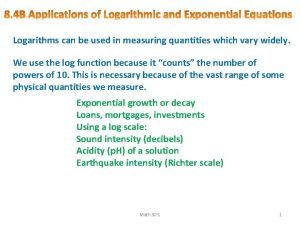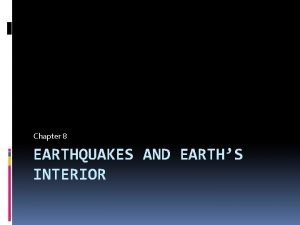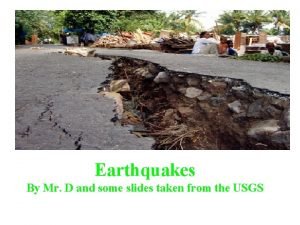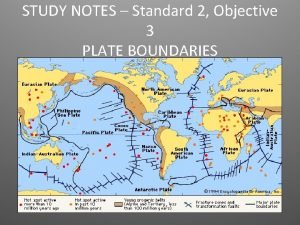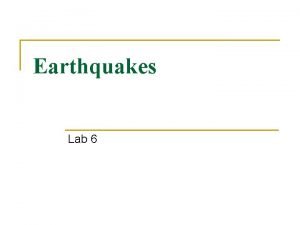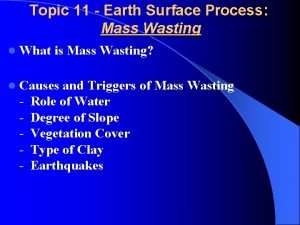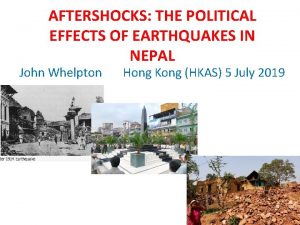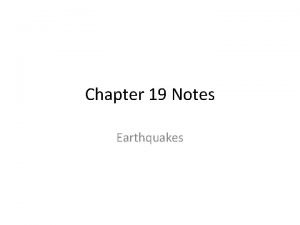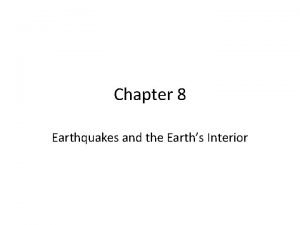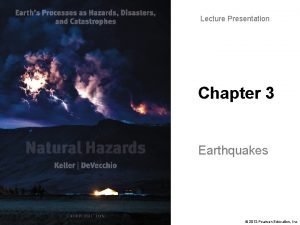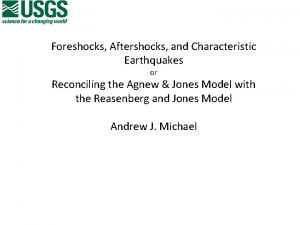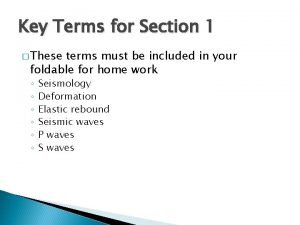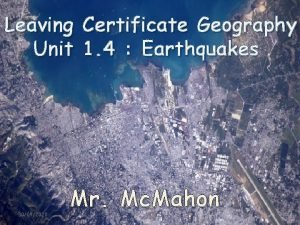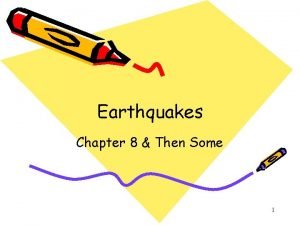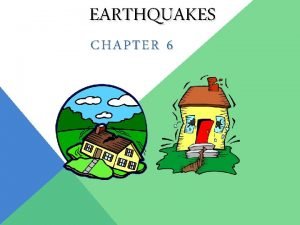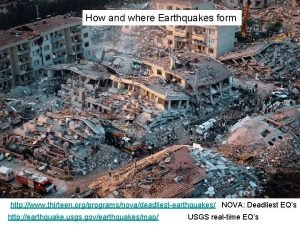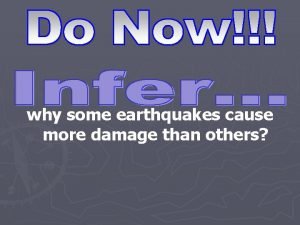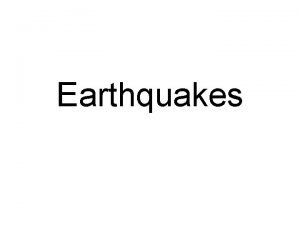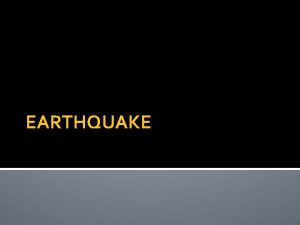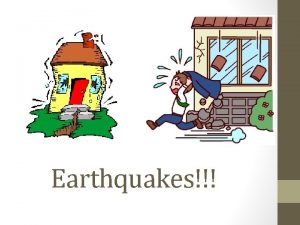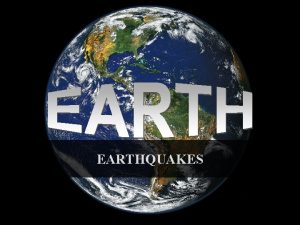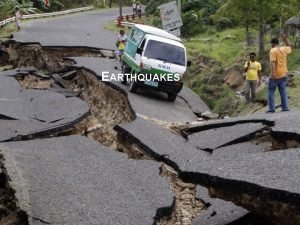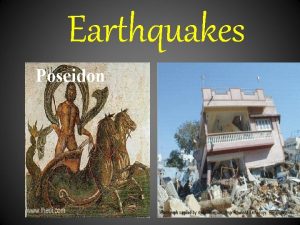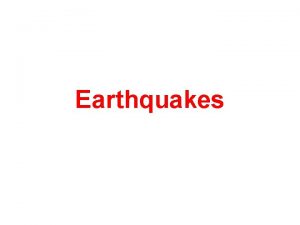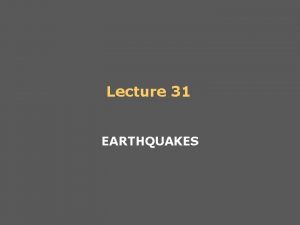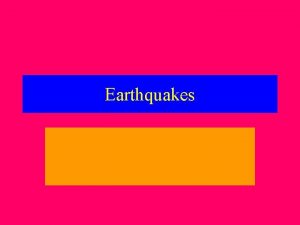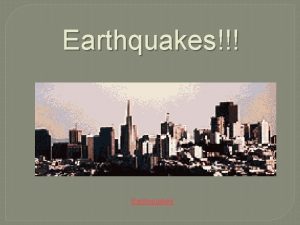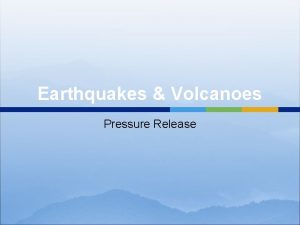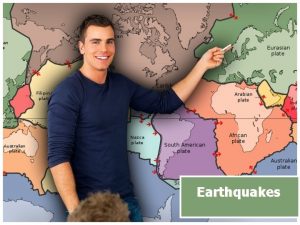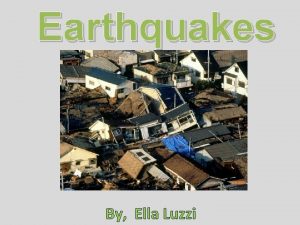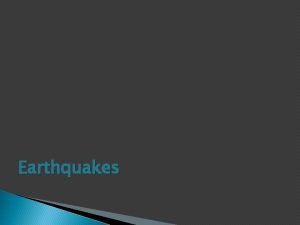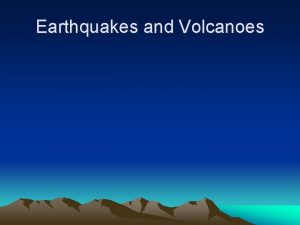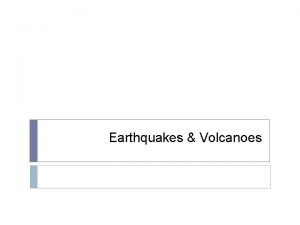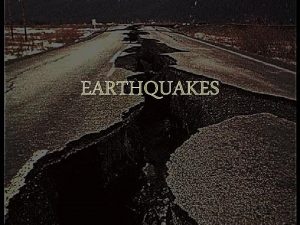EARTHQUAKES 2017 What is an Earthquake An earthquake

























- Slides: 25

EARTHQUAKES 2017

What is an Earthquake?

An earthquake is the vibrations produced when rock snaps and breaks under force.

Objects can only withstand so much force: - A stick will snap when bent too far. - A rubber band will break if pulled too tight.

An elastic limit is the maximum force an object can withstand

1. Rocks have an elastic limit. 2. Rocks will actually bend until they reach their elastic limit. 3. When rocks bend too far, they will then break. 4. The break or crack in the rock of earth’s crust is called a fault.

Faults form when earth’s plates move and place stress on one another, eventually forcing the crust to snap.

How Do Earthquakes Form?

Earthquakes occur when rocks move past each other along a fault.

-Rocks have jagged edges. - The jagged edges along a fault get stuck. - Stress builds up in the stuck rock as the plates try to move. - The rocks bend until they reach their elastic limit and break. - The rocks snap back to their original position (elastic rebound) - The breaking of the rock creates an earthquake.

MOVEMENT ALONG FAULTS: TYPES OF FORCES

Foot wall: The block of rock below the fault line. (Imagine being able to walk on it as if it were the floor below you).

Foot wall

Hanging wall: The block of rock above the fault line. (Imagine being able to hang something from it as if it were a ceiling. .

Hanging wall

WHAT ARE THE MAJOR TYPES OF FAULTS? There are 3 major types of faults: -Normal Faults -Reverse Faults -Strike/Slip faults.

Normal Faults 1. Caused by forces of tension (stretching). Type of force is tension. 2. Tension forces pull rock apart. 3. Tension causes the hanging wall to move down. 4. This is called a normal fault.


Reverse Faults 1. Caused by forces of compression (pushing). 2. Compression forces squeeze rock together. 3. Compression causes the hanging wall to move up. 4. This is called a reverse fault.


Strike/Slip Faults 1. Caused by forces of shearing (sliding). 2. Shearing forces move rock in opposite directions. 3. The movement is only in a horizontal direction. 4. This is called a strike/slip fault.


When rocks break and an earthquake occurs a significant amount of stored energy is released. - The energy travels through Earth in the form of waves. - The waves are called seismic waves. - The waves start in the crust where the rocks break.

-This location is called the focus. - The seismic waves travel outward from this point. - This outward traveling energy causes earthquake damage.

NEXT TIME……. . Seismic waves and why they are so dangerous……. .
 Http://earthquake.usgs.gov/earthquakes/map/
Http://earthquake.usgs.gov/earthquakes/map/ Chapter 8 earthquakes and earth's interior
Chapter 8 earthquakes and earth's interior Types of earthquake
Types of earthquake A large crack in the earth formed by a river or earthquakes
A large crack in the earth formed by a river or earthquakes Two types of body waves
Two types of body waves Frequent earthquakes in an area may indicate
Frequent earthquakes in an area may indicate Chapter 8 section 3 earthquakes and society answer key
Chapter 8 section 3 earthquakes and society answer key Example of diastrophism
Example of diastrophism Landslides caused by earthquakes
Landslides caused by earthquakes Earthquakes
Earthquakes Chapter 19 earthquakes
Chapter 19 earthquakes Chapter 8 earthquakes and earth's interior
Chapter 8 earthquakes and earth's interior Pearson
Pearson Earthquakes
Earthquakes Define natural disasters
Define natural disasters Causes of earthquake in points
Causes of earthquake in points Elastic rebound theory
Elastic rebound theory Chapter 19 earthquakes
Chapter 19 earthquakes How high does the richter scale go
How high does the richter scale go In what section of earth do earthquakes happen?
In what section of earth do earthquakes happen? Chapter 8 quiz 1
Chapter 8 quiz 1 Chapter 8 earthquakes and volcanoes
Chapter 8 earthquakes and volcanoes Whats the main cause of earthquakes
Whats the main cause of earthquakes Why do earthquakes occur
Why do earthquakes occur Why do some earthquakes cause more damage than others
Why do some earthquakes cause more damage than others The point on the ground directly above the focus
The point on the ground directly above the focus
